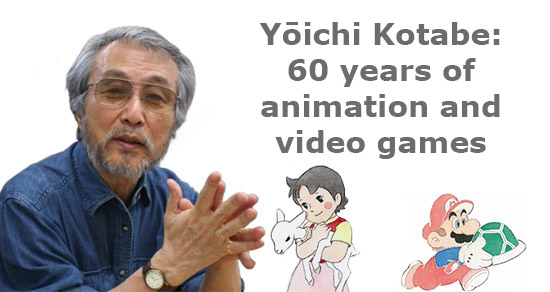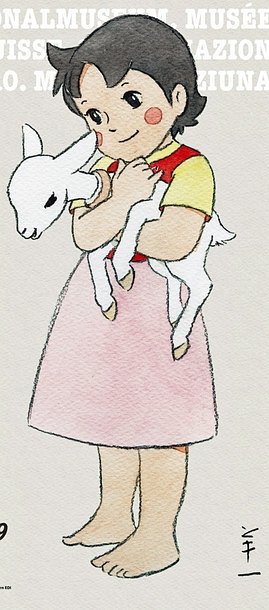






Table of contents :
Part I: The Tōei era
Part II: From one studio to another
Part III: From animation to Nintendo
Part IV: Diversification and transmission
Part V: Towards new horizons
Sources
Appendix : Works on which Yōichi Kotabe has worked
During the 2000s and 2010s, Kotabe continued his work as animation supervisor on works adapted from licenses partially or wholly owned by Nintendo, whether it be the many films and series drawn from the Pokémon universe or the TV series Hoshi no Kirby. But it was on a work with no connection to the video game company that he made a new return as an animator in 2003. Led by Kihachirō Kawamoto and gathering more than thirty animators and directors coming from all horizons, among whom we can count Isao Takahata and Yuri Norstein, Fuyu no Hi / Winter Days was also the occasion of a professional reunion between Kotabe and Reiko Okuyama, who directed and co-animated a segment with her husband.
He also had the idea to adapt his wife's copper engravings into animation, but his project never materialized.
On May 6, 2007, Reiko Okuyama died at the age of 70 from pneumonia. After 21 years at Nintendo, Kotabe decided to leave the company and go back to freelancing.
A few years earlier, he looked back on his career in video games and gave the beginning of an answer to those who wondered what kept him at Nintendo all those years:
"Rather than creation, I would say the desire to create something attractive that immediately arouses interest. You could find that in the Tōei films of the past. What interests me in animation is this 'kneading' work, the fact that we all put our hands to the work together. It is through this common process that a film is born. I didn't feel this movement anymore in the animated production of the 80's and I found it again in the video game. Since then, times have changed and we have arrived at three-dimensional video games, but the greatest games are still created on this principle. The need to benefit from the know-how of the animation people has grown quite significantly. I think that now there is a much greater involvement of animators in games."
The man who used to be the most recognized official Mario illustrator did not cut ties with his former employer, however, especially when his former disciple, Yoshiaki Koizumi, wanted to show him Flipnote Studio, an animation software that adapted the flipbook concept to the DS. Kotabe took the opportunity to make a video demonstration during an interview with Nintendo former president Satoru Iwata.
If Koizumi has since acquired important responsibilities within Nintendo and is no longer able to continue producing official illustrations, other artists have taken over, in particular Shigehisa Nakaue. Nakaue has become the main illustrator of the plumber within Nintendo for 2D illustrations, and his style is in line with Kotabe's, to the point that Nakaue's illustrations are regularly attributed to him. A phenomenon that is no stranger to the former Tōei since, when The Legend of Zelda: The Wind Waker was unveiled, many saw in the aesthetics of the game a sign of his involvement in the project.
The visual style of Wanpaku Ōji no Orochi Taiji, the waves of Animal Treasure Island... If Breath of the Wild leans towards Ghibli and Hayao Miyazaki (and more particularly Nausicaä), Wind Waker is more inspired by classic Tōei. Thus, this should not necessarily be seen as an involvement of Kotabe (who denied having participated in the development of Wind Waker), but rather as an influence of anime, to which Kotabe contributed in no small way. Moreover, the designer of the Link from Wind Waker - Yoshiki Haruhana - is none other than a disciple of Kotabe. He notably produced illustrations for Super Mario World 2: Yoshi's Island and Kirby's Dream Course, and was the art director for the remake of Link's Awakening.
In 2017, health problems forced Kotabe to put his career on hold, with no certainty of ever being able to continue it. His condition was such that he was hospitalized for 5 months and his son started to prepare his funeral. However, he managed to get back on his feet and even responded to festival invitations sent from all over the world the following year, whether from Annecy in France, Kyōto in Japan or Zurich in Switzerland.

Heidi in Japan, illustration created by Kotabe for the exhibition held at the National Museum of Zurich in 2019.
His last known collaboration with Nintendo, however, seems to predate this period of hospitalization by a few months since the last works crediting him date back to 2016 with the TV series adaptation of Pokémon XY & Z and Pokémon the Movie: Volcanion and the Mechanical Marvel. Moreover, it seems that the collaboration between the Japanese developer and Kotabe has continued mainly in the field of animation after his departure from the company. Although he had already spoken about Nintendo in interviews when he was an employee, it is especially during the last few years that we have become aware of the content and the extent of the work he has done there.
We also recently learned that he had played some of the games produced by Nintendo during his career, starting with Dr. Mario (1990).
"I was happy to play games as part of my job, but my passions were Dr. Mario and Donkey Kong.
I heard that Mr. Ōtsuka was playing Game Boy with the door closed in his office at Telecom Animation, and when I met him, I told him about Dr Mario."
"When I played it as best as I could, I sometimes exceeded Mr. Ōtsuka's score. He had his own office and I could see him playing it through the glass (laughs). He was so frustrated that he lost to me. And then he passed me again."
Regarding Donkey Kong, he appreciates the character himself and had the opportunity to play Donkey Kong 64 (1999), developed by the English company Rare.
"I had an unintentional influence on Donkey Kong 64. At Nintendo, to test games in development, we used a debug console, and in this one, when you died, you went back to the beginning of the sequence instead of being sent back to the beginning of the level. I borrowed it one day and, thanks to this system, I managed to finish the game. But when Miyamoto found out (without knowing that a particular console was involved), he was alarmed that the game was far too easy. He raised the difficulty, and eventually the players found it too hard, and it sold poorly (he bursts out laughing)."
In 2019, Kotabe collaborated on the drama Natsuzora, a live-action series featuring a character inspired by Reiko Okuyama and her career at Tōei. He first worked on it as a consultant on the history of the studio, even though the studio, characters and animated works featured in it are fictional, and then as a character designer for one episode. However, this second position was not originally assigned to him. Hitomi Tateno, former Ghibli animator and supervisor of the animation on the series, had to take charge of the creation of this character taking into account the fact that it was a character which had to be integrated into a work of the 60s. The latter, not feeling able to bring to her drawing a touch able to convince the public of the authenticity of what they watch, suggested to the production to turn to Kotabe, "only person able to draw such a character". At first, Kotabe refused, arguing that he could no longer draw as he would have done at the time. However, the producer did not give up and the animator finally let himself be convinced, on the condition that he was described the character in question as well as the story of the film in which they were supposed to evolve. Once this condition was met, he designed Chiara, a character whose costume and silhouette are reminiscent of those of Hilda from the film Horus, Prince of the Sun.

Chiara, the character designed by Kotabe for a fictional work
This return to the position of character designer was not an isolated act, since in the same year, on the occasion of the centenary of the Calpis drink, Kotabe participated in a short film featuring its creator, shown at the Calpis Mirai no Museum.

Characters and illustration drawn by Kotabe for the Calpis centennial film
At 85, Kotabe remains one of the great names of Japanese animation and one of the living memories of the industry. His public appearances are all the more precious as he is now one of the last living personalities to have worked at the Tōei Dōga from its beginnings or almost, many of his closest colleagues and friends having since passed away, from Yasuji Mori to Yasuo Ōtsuka to Reiko Okuyama or Isao Takahata.
Although he did not work on the film in question, Kotabe is sometimes invited as an indirect witness to speak about The White Snake Enchantress, now considered a legacy work that deserves to be brought to light. Again this year, he will participate in an exhibition centered on Heidi, which is scheduled to be held at the Hamamatsu City Museum of Art.
His work has already been the subject of several exhibitions, centered on Heidi or on his entire career, notably in November 2020 at the Shiinoki Cultural Center in Ishikawa Prefecture. A part of his work has been gathered in the book Yōichi Kotabe Legendary Animator - His Animated Drawings released in 2008, then reissued in an enhanced version in 2019. This artbook, which was in gestation for years, reproduces numerous photos as well as the bulk of the drawings he still had in his possession at the time of its completion, whether they were made as part of an animated work or, more rarely, a video game.
On a related note, the variety of sources and the quantity of information relating to his work in animation remain far superior to what can be found concerning his involvement in the video game industry, even though his reputation in this field has increased in recent years. Both a veteran of animation and video games, Kotabe's style is now as much associated with Heidi as it is with Nintendo, which is well aware of this. Nevertheless, the company also seeks not to lock itself into a single style, as Miyamoto recently explained:
"Of course, the development team for any Mario game may want to adopt Kotabe's visual style, but there is also a character development team that works really hard to create new styles and new works."
That leaves his influence, his contribution to a whole swath of the imagination of gamers and animation fans around the world, and the hope that maybe one day Nintendo will partner with a publisher to produce an artbook featuring the man's work.

A portrait of Mario made in 2014 by Kotabe